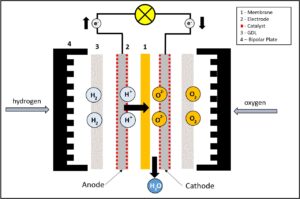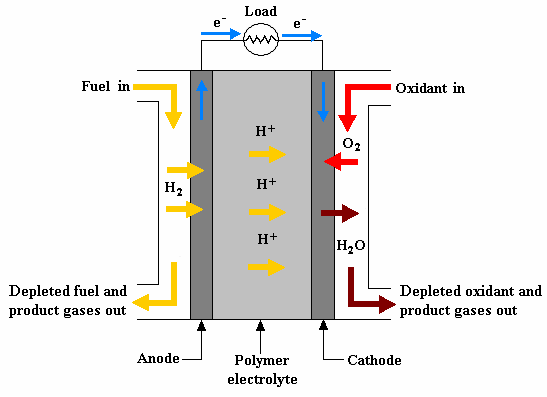Fuel cells are often discussed for their capacity to produce clean energy. Even so, the workings behind this involve a complicated system of gases flowing between the anode and cathode plates. Paying attention to these flow patterns can help improve a fuel cell’s functioning.
We can explore why small changes in turbine design can greatly affect how efficiently, powerfully, and strongly it runs. Also, what are the flow patterns of anode and cathode fluids in fuel cell plates?
Understanding Fuel Cell Plates
Structure of Fuel Cell Plates
Fuel cell plates, or bipolar plates, have a greater purpose than only keeping catalyst layers separated. They move hydrogen and oxygen gases where they are needed to go. These plates contain flow fields: cunningly formed channels that move the gases across the MEA surface.

How Anode and Cathode Flow Fields Work
It is usual for oxygen or air to go to the cathode and for hydrogen to go to the anode side of the fuel cell. How the gases are brought, delivered, and handled is very important. Even reaction of the gases occurs thanks to the flow fields, and the byproduct, water, is handled efficiently.
Some Basic Principles of Flow Patterns of Anode and Cathode Fluids in Fuel Cell Plates
Reactant Flow Basics
Hydrogen and oxygen in the fuel cell are put to work immediately. Electrochemical changes happen between the MEA and the electrolytes, causing the production of electricity. Many things can make this process less simple, like high pressure, changes in temperature, and humidity.
Factors Affecting Flow: Pressure, Humidity, Temperature
Pressure : It is possible to increase the rate of a reaction by applying higher pressure, though this may also cause the equipment to feel increased stress.
Humidity : Good conduction of protons on the membrane depends on moisture.
Temperature : It impacts the speed at which reactions take place and how fast water is evaporated inside the cell.
Types of Flow Patterns of Anode and Cathode Fluids in Fuel Cell Plates
Co-current Flow
The pattern shows that gases travel from both the anode and cathode in the same way.
Advantages
- Simple to implement
- It is easier to control the power supply when it is not at high levels.
Disadvantages
- Uneven humidity distribution
- May cause water to run out at the end of the pipe and pour in through the start of the pipe
Countercurrent Flow
In this design, the gases pass from opposite sides of the membrane.
Why It Works
- Promotes more uniform humidity
- Improves membrane hydration
- Enhances proton conductivity
It shows how water production can be balanced with water consumption, mostly in cases where high currents are flowing.

Transverse Flow
Molecules of gas move horizontally from left to right, and molecules of the other from top to bottom.
Where It Helps
- Plays a role in the development of specialized cells for specific designs
- Promotes local turbulence, enhances mixing
Comparative Analysis of Flow Patterns
Comparison of Catalyst Behavior at Low and High Current Densities
When there is a small amount of current, the differences between different flow patterns are not very noticeable.
The use of countercurrent flow improves at high current densities due to the better management of water and the better hydration of the membranes.
Water Management in Different Patterns
Co-current : There is a risk that the membrane may dry out at the outlet.
Countercurrent : Balanced hydration across the cell.
Transverse: Lower costs in some places, but designing and maintaining the overall system is more challenging.
Effects on the Moisture and Resilience of the Membrane
When a membrane gets dehydrated, it stops conducting protons, and when it is wet, it minimizes the flow of gas. Countercurrent flow plays a role in keeping the membrane moist and strong for a longer period.
Case Study: Serpentine Flow Channels
One serpentine channel with an area of 100 cm² was used for a study of the three flow patterns. The results?
- It was found that water moved more evenly with countercurrent flow.
- It resulted in both raised levels of power output and increased cell durability.
- With co-current flow, there were uneven levels of water removal.

Effect of Flow Channel Depth
Deep vs. Shallow Flow Channels
Having a deeper channel allows for more reactants to collect and helps manage the removal of water, especially if the flow is reversed.
Impact
The unique mix of a wider channel and opposite flow ensures a better performance.
- Lower pressure drop
- Improved mass transport
How Air Intake Takes Place and Its Effect
- Besides thinking about the direction of airflow, you should also focus on how you supply the air.
- Central inlet design improves symmetry.
- The placement of the antenna near walls can make certain spots unreachable by the signal.
- By making the air temperature the same in each room, it is easier for the air to remain uniform.
MEA and Flow Dynamics
The Membrane Electrode Assembly (MEA) plays the most important role in the process. If the plot isn’t directed well, the whole thing can fall flat.
- Not having the blood flow right can either dry the MEA or cause flooding.
- The movement of liquids and solids in the reactor impacts careful reactant spreading and managing moisture.

Water Management Strategies
Why It’s Crucial
- If the cell is filled with water, it will not function properly. If there is not enough water, it can break.
- Countercurrent helps in self-regulation.
- Water is easily guided by the use of channels and hydrophilic coatings.
- Correct depth and slope in the channel allow water to flow easily.
Ensuring that the system’s flow design is optimized for the highest efficiency
- Approaching education with a single method would not be effective.
- Flow fields can be effectively simulated and improved using CFD modeling.
- Designing patterns to meet the requirements of the environment makes the system more efficient.
- With the use of real-time sensors and smart controls, flows can now be quickly changed as needed.
Innovations in Flow Field Design
- Smart designs are the new focus, rather than just elegant and sophisticated ones.
- Bio-inspired patterns mimic leaf veins.
- 3D-printed channels allow for custom geometries.
- They make use of the strengths of each type of flow.
Challenges and Future Trends
Fuel cell systems are still being improved and developed. Some key hurdles include:
Balancing cost with performance
- Ensuring scalability for industrial applications
- Integrating with wind/solar systems
- Developing adaptive flow designs
Conclusion
There is one thing about fuel cells that many people don’t notice that plays a key role in their achievements: the way gases flow. Research shows that the type of pattern matters and could mean the difference between the success or failure of the system.
When it comes to keeping the battery hydrated, long-lasting, and effective at high powers, countercurrent flow stands out. Yet, understanding flow patterns of Anode and cathode fluids in fuel cell plates is only a small part of a greater problem that covers channel shape, the design of the inlet and how the flow is controlled in real time. Therefore, when you come across a fuel cell, realise that chemistry is only a part of what it does. You need to think about strong and flexible choreography.
Visit our website for more informational content.

